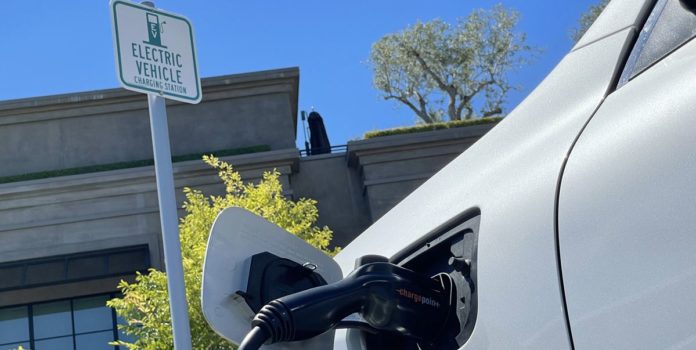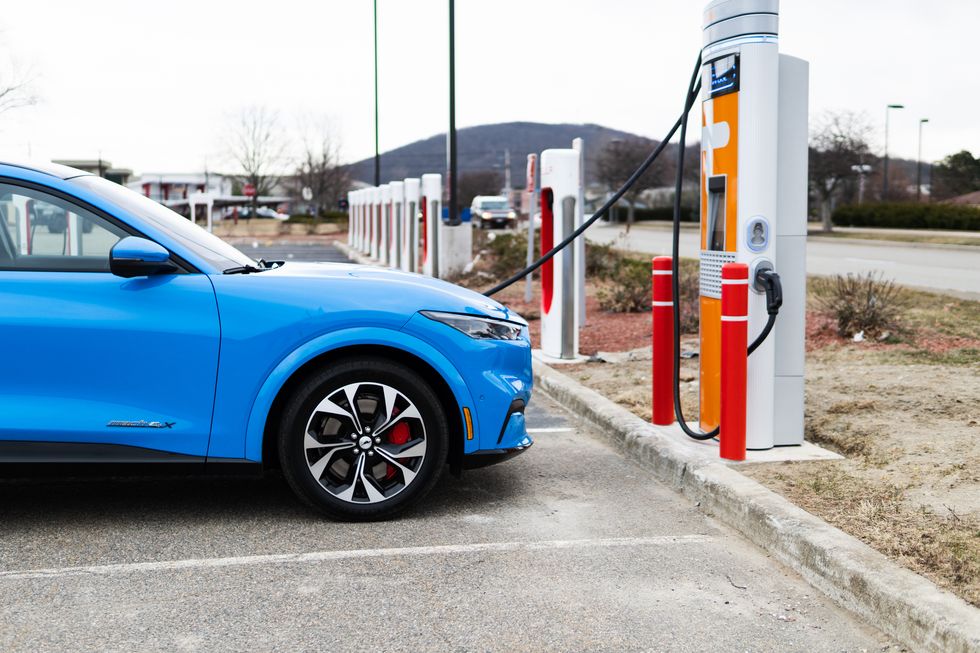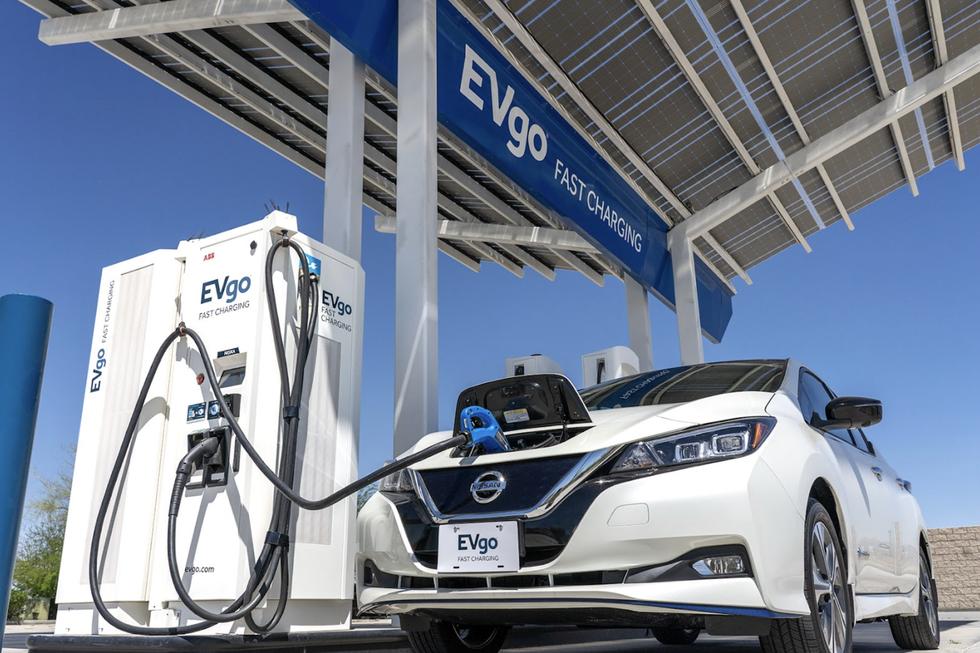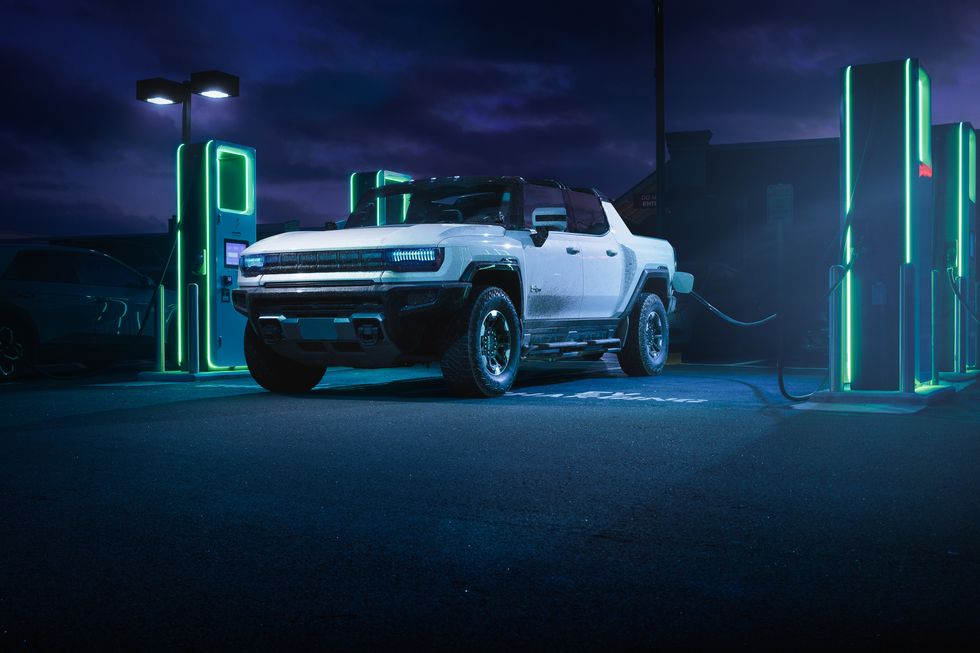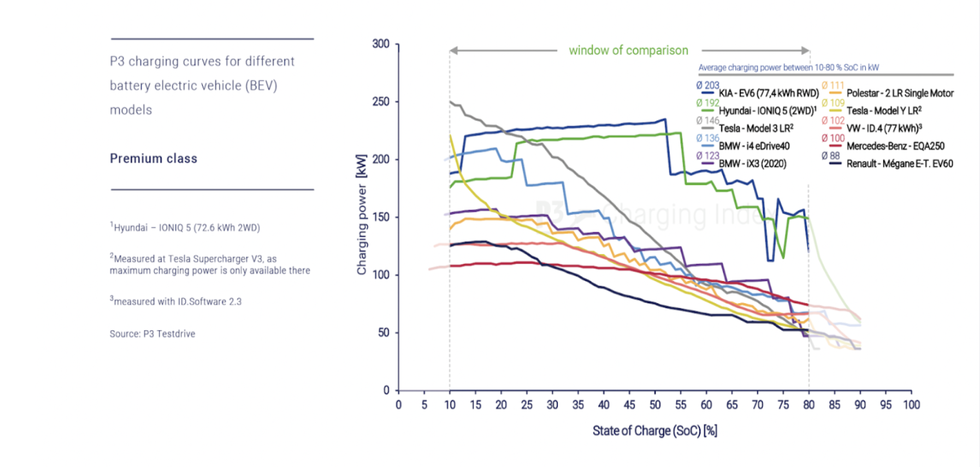It is a common assumption that it takes more time for an EV to charge than for a conventional vehicle to refuel at a pump. This isn’t an unreasonable assumption. After all, electric cars can take between 30 minutes and a week to charge, depending on a variety of factors. How could anyone fit so much charge time into their everyday life?
But many new EV adopters will spend less time waiting for their vehicle to charge than they are used to spending at the pump, though the time might be concentrated into fewer, longer visits per year. Unlike gas pumps, chargers allow owners to set up a session and walk away. For an average U.S. driver, charging overnight at even the slowest charger will provide more than enough juice to get through the next day.
As illustrated here, this all can be easily calculated based on the length of daily travel, vehicle efficiency, and charger operation. The obvious stuff.
Level 1 Charging
Level 1 charging is plugging a car directly into a standard 120V wall outlet. All EVs come with the required cables, so assuming one has electrical service (according to the World Bank, that’s 100 percent of the United States population), there’s no additional upfront cost. The maximum power obtainable from an outlet is the voltage multiplied by the maximum electrical current, measured in amps, that won’t trip the circuit breaker: P(power) = I(current) * V(voltage).
In the U.S., the most common amperage allowed on a 120V circuit is 15 amps, which translates to 1800 watts or 1.8 kW of power. To leave a bit of extra safety margin, companies generally cap consumer devices around 1500 watts (1.5 kW), which is a typical rating for any significant heating devices like space heaters, kettles, and hair dryers.
The math for how long a car takes to charge is simple at low rates like this. It’s the energy capacity of the EV’s battery in kWh divided by the power the charger delivers in kW. Assuming a capacity of 75 kWh, the time to charge from completely empty to totally full can be calculated as follows:
75 kWh / 1.5 kW = 50 hours = ~2 days
Two days is too long, but given the limited miles most people drive daily, access to overnight charging allows average drivers to keep their vehicles sufficiently charged using a Level 1 charger. “Most people” obviously aren’t all people. And Level 1 charging is best used by EV owners with consistent and predictable driving patterns within the parameters of the vehicle’s range and performance.
For example, assume a 40-mile round-trip daily commute, leaving the house at 8 a.m. and arriving home around 7 p.m. With a reasonably efficient car like a Tesla Model 3 or Lucid Air, expect to consume energy at a rate of around 250 Wh/mile. Plugging in after arriving back home would require about seven hours to charge fully.
Bottom line on L1 charging: A Level 1 charger can provide up to roughly twice the energy required to cover the average commute in the U.S. But it won’t be possible for everyone to rely on such a slow charger.
Level 2 Charging
Level 2 charging is similar to Level 1, but instead of connecting to a 120V circuit, the EV connects to a 208-240V circuit that supports a higher current and delivers more power. Beyond that, how much power an EV can use varies. All EVs have an onboard charger, where the required conversion from AC to DC happens for L1 and L2 charging, and the maximum power that this charger can deliver to the battery ranges by car.
The Amperage of 240V Circuits
Homes are generally wired to support at least a few 240V devices, like clothes dryers, ovens, cooktops, and water heaters, which require more than 1.5 kW. Again, because P(power) = I(current) * V(voltage), how much power can be drawn from an outlet on one 240V circuit depends on how many amps of current that circuit is configured to support. Typically, these circuits are between 20 and 100 amps. Meanwhile, a wall-mounted L2 charger—which is really a glorified extension cord— is typically rated between 16 and 80 amps, including a safety margin. This means the range of power that could be delivered from your outlet to your EV is between 3.8 and 19.2 kW.
The Onboard Charger
That’s not the end of the analysis for determining charging speed because once the power level gets that high, there is a second choke-point besides the circuit breaker and charging cord, and it’s inside the car. With both L1 and L2 charging, what enables plugging into a regular outlet is the conversion from AC to DC that happens inside the car. As mentioned above, every EV has an onboard charger with a maximum amount of power it can deliver to the battery.
Generally, the larger the battery on the car, the larger the onboard charger will be. A Tesla Model 3 and Hyundai Ioniq 5 have an 11-kW onboard charger, while the GMC Hummer EV and Ford’s F150 Lightning have 19.2-kW units. With smaller EVs, there is no additional benefit to installing a 80-amp charger versus a 48-amp in a home, as the car will be limited by its onboard charger.
So, calculating how long it takes to charge fully using L2 charging is different from L1, depending on the onboard charger. First, calculate the power delivered by the circuit, which is 240V multiplied by the circuit’s amp rating minus a 20% safety margin (ie 30A becomes 24A).
240V * 24A = 5.8kW
The power delivered to the car is whatever is smaller between the circuit power and the power of the car’s onboard charger. Then, divide the battery capacity by the power delivered to the car. For an Ioniq 5 with a 77kWh battery and a 11kW onboard charger, the math for various charging options is as follows:
77 kWh / 5.8 kW (24A) = 13 hours
77 kWh / 7.7 kW (32A) = 10 hours
77 kWh / 9.6 kW (40A) = 8 hours
77 kWh / 11 kW (48A or 80A) = 7 hours
On the flip side, more powerful chargers may be necessary to charge a larger, more heavily used vehicle overnight fully. The Ford F150 Lightning has a 131-kWh battery and a 19.2-kW onboard charger that doesn’t max out on a 48A-amp charger, so the full charge times for it are as follows:
131 kWh / 5.8 kW (24A) = 23 hours
131 kWh / 7.7 kW (32A) = 17 hours
131 kWh / 9.6 kW (40A) = 14 hours
131 kWh / 11 kW (48A) = 12 hours
131 kWh / 19.2 kW (80A) = 6.8 hours
Finally, some new examples of extremely large EVs really push the limits of what L2 charging infrastructure can handle in a reasonable amount of time. The Cadillac Escalade IQ has a 200-kWh battery, the GMC Hummer EV boasts 212 kWh, and the upcoming Dodge Ram REV holds up to a staggering 229-kWh battery. Let’s do the same math for the Dodge.
229 kWh / 5.8 kW (24A) = 40 hours
229 kWh / 7.7 kW (32A) = 30 hours
229 kWh / 9.6 kW (40A) = 24 hours
229 kWh / 11 kW (48A) = 21 hours
229 kWh / 19.2 kW (80A) = 12 hours
And just as a point of reference, if the Dodge is stuck with L1 charging at 1.5 kW, that’s more than 152 hours to fully charge.
Bottom line on L2 charging: A Tesla Model 3 or Hyundai Ioniq 5 can fully charge overnight in 13 hours, even if stuck with relatively low amperage. Double the amperage, and it could fill in half that time. And if you expect to make the most of an EV truck’s range on back-to-back days, a high-amperage L2 home charger makes that feasible. Public L2 chargers have a similar range of power ratings, so check PlugShare to know how powerful a charger is when planning a trip.
DC Fast-Charging
DC fast-charging, sometimes called Level 3 charging, is where things get complicated on the technical side. L3 chargers use their own external inverters to deliver DC directly into the battery, bypassing the car’s onboard charger. Here, the limiting factor might be the charger and cord, the car battery itself, or both at different times during the charging session.
Charger Power, Cord Current, and Car Voltage
The first variable to consider is the speed of the charger, which is not necessarily straightforward. You’ll find that chargers advertise the maximum power they can deliver in theory, but that might not match the power your car in fact gets.
To understand this, let’s go back to that key equation: P(power) = I(current) * V(voltage). At a given power, the lower the voltage, the higher the current required to deliver it, and vice versa. L3 chargers are generally given a kW rating that describes the maximum power the inverters in the chargers can dispense—and currently, that’s as high as 350 kW (with faster ones planned), which is 18 times as much as any onboard charger could handle for L2 charging purposes. But to actually draw that much power requires sufficiently high voltage and current. Voltage depends on the car, and current depends on the charging cord.
To start, vehicles have batteries that operate at different voltages. The vast majority of EVs on the road are around 400V. This lower voltage means a higher current is required to reach a given power level. To carry a higher current safely, the cables used to connect the charger to an EV need to be thicker, water-cooled, or both, adding significant expense to the charger. As a result, it is not uncommon for charger manufacturers to communicate the power rating of their chargers at 1000V, only for them to deliver less than half that rated power to 400V cars because that is all their cables can handle. It can be hard to tease out what the cable rating is for any charger, but on PlugShare, people are complaining that they are getting roughly half the rated power out of a charger, the likely culprit being the low current–carrying capacity of the cable. That said, the cable rating is not a particular concern with the few 800V+ cars currently on the road, such as the newer Hyundai, Kia, Porsche, and GM EVs.
Charging Curve
The other major factor determining charging speed is battery chemistry. At higher power levels, lithium-ion batteries charge on a curve, typically receiving less charge as they reach higher states of charge. This phenomenon is apparent with smartphones, as they charge from 10 percent to 20 percent much faster than from 90 percent to full.
This curve declines so sharply that the commonly stated metric for fast-charging speed is the time it takes for an EV to charge from 10 percent to 80 percent because ‘fast-charging’ above 80 percent isn’t fast at all. Below, you can see the different charging curves for various EVs, showing the relationship between the car’s state of charge and the power that its battery can receive.
It’s important to know that how fast a car charges in the real world is not a function of the peak power the car receives. What matters is the average charging speed, depicted in the graph below as the area under the charging curve.
Using the example below, the Tesla Model 3 LR and the Kia EV6 may both reach a peak power of roughly 250 kW, but the Kia maintains that power for longer, reportedly charging from 10 percent to 80 percent in 18 minutes, whereas the Model 3 LR typically takes closer to 30.
Battery Capacity
Another factor is the capacity of the battery. The charge curves above hold whether your battery is 60 kWh or 200 kWh, so the larger the battery, the more energy you are getting in a certain amount of time. For cars that offer two different battery sizes, the larger battery not only has more range but also gets more miles per minute when charging. The Kia EV6 Light (standard range) and Wind (long range) may both go from 10 to 80 percent in around 20 minutes, but the Light gains only 162 miles in that time, while the Wind gains 217—a not-insignificant difference.
Environmental Factors
Finally, there are a number of external factors that may affect how quickly your EV charges at a DC fast-charger, but most of them relate in one way or another to temperature.
Batteries like to be kept within a certain temperature range. Charging or discharging at a battery’s maximum performance narrows that range considerably. Arrive at a DC fast-charger in a cold car with a cold battery on a winter day, and it’s likely all that will be delivered are Level 2 charging speeds for the first 20 minutes of the charge session.
Temperature is so vital a consideration that Tesla has two features in its software: Smart Preconditioning and Drag Strip Mode. These settings do essentially the same thing but for different reasons. Smart Preconditioning kicks in whenever the driver inputs a Supercharger as the destination in the navigation system, warming the battery as you approach so that it will be at the optimum temperature for maximum charging speed. Drag Strip Mode does the same on request but for the purpose of optimizing vehicle performance.
Because charging itself heats the battery, some care must also be taken not to allow it to get too hot. Most modern EVs will actively cool their batteries once they are up to temp to keep them in the best range. Rivian, in an effort to increase the charging performance of their vehicles further, has patented chargers that blow cool, conditioned air vaguely in the direction of the battery in an effort to aid that process.
Worn-out charging connectors will also slow down your charging experience. As connectors wear out with use, resistance between the cable and the car increases, resulting in the connector heating up. Fortunately, there are temperature sensors in the EV and in the connector to ensure that nothing is damaged, but the way this outcome is avoided is by lowering the amount of power being sent to the car. After software issues, these connectors are one of the most common points of failure for DC fast-chargers, and if a charger is performing worse than expected, using an adjacent charger (or a different connector on models with more than one) may speed things up.
Bottom line on fast-charging: Many modern EVs have the capability to charge from 10 percent to 80 percent in under 45 minutes with an L3 blast. Some even have the ability to get there in half the time, assuming a sufficiently powerful charger.
With reliable access to an L1 or L2 charger, private or public, how much time is spent charging shouldn’t be anything close to how much time an EV charges. An EV is bigger and more sophisticated than other major battery-powered devices, but the basic principle holds: With smart habits, the time used to charge on a daily basis should be the seconds it takes to grab or detach the charging cable.
For drivers with unusual distances to cover and no such reliable overnight access, the current reality is waiting at a fast-charger and for longer, often much longer, than it takes to fill a liquid fuel tank. But with the expansion of public L2 charging options and improvements in battery technology and fast charging infrastructure, soon this will be an inconvenience incurred only by those using their vehicle all day—and the wait will shrink.
Contributing Editor
An aerospace engineer with a life-long passion for anything with wheels or wings, Will has spent his career building everything from bicycles to bathrooms.
He once ran an after-hours communal car workshop in an abandoned South Bronx laundromat, restoring his first and last car, a Datsun 240z, and had a Suzuki SV650 blown up by ConEd.
Watts later followed his name and joined Tesla’s charging team, and now writes about EVs and infrastructure.

